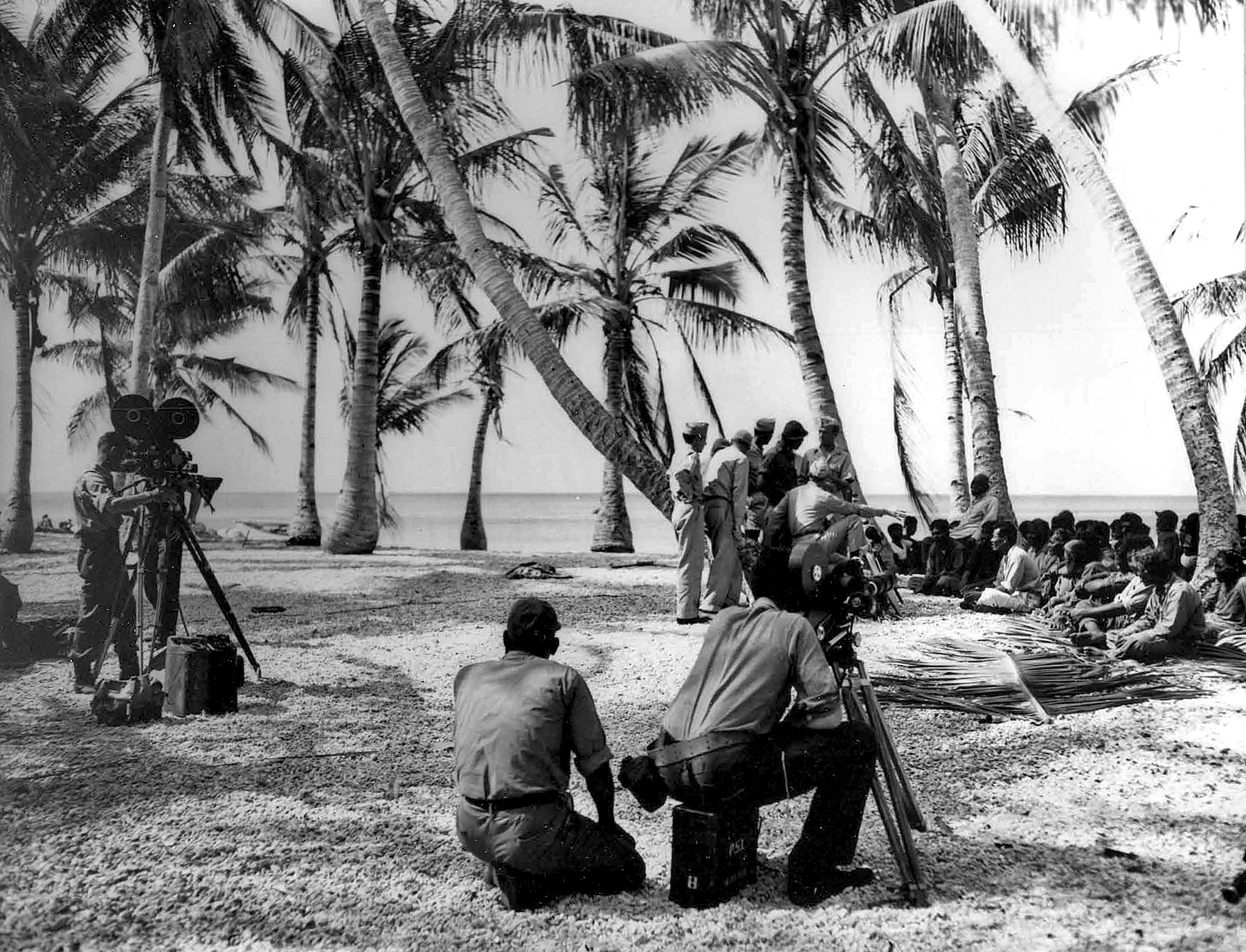“We will go believing that everything is in the hands of God.”
King Juda
After WWI ended in the early 1900s, the Japanese took over administration of the Marshall Islands. In anticipation of WWII, the military presence in the islands intensified. Bikini, Truk Lagoon, and other low-lying coral atolls suddenly became strategic points of interest.
Life for the Marshall Islanders wasn’t peaceful anymore as the Japanese began building watchtowers to keep an eye out for an American invasion. Kwajalein Atoll in particular became a key Japanese outpost. In February 1944, American forces took Kwajalein and the Marshall Islands by force.
There were five Japanese soldiers left on Bikini. Instead of allowing themselves to be captured, they blew themselves up with a grenade while hiding out in a foxhole.
In December 1945, President Harry Truman informed the US Forces that nuclear weapon testing would be undertaken “to determine the effect of atomic bombs on American warships.”
Unluckily for Bikini, its isolation meant it was chosen as the Operation Crossroads test site.
Commodore Wyatt, then military governor of the Marshall Islands, went to Bikini in February 1946. After church on a Sunday, he gathered the native Bikini Islanders and asked them to leave their home so the US could begin testing bombs. He stated it was for “the good of mankind and to end all world wars.”
King Juda, the Bikini monarch, was understandably confused but entered into discussions with his people. They decided to leave: “We will go believing that everything is in the hands of God.”
While the islanders were preparing for their enforced exodus. The US testing program advanced swiftly. A total of 242 naval ships, 156 aircraft, 25,000 radiation recording tools and 5,400 animals arrived. The latter were to serve as test subjects. More than 42,000 US personnel played a part in the testing program.
The Crossroads tests were the first of other nuclear tests in the Marshalls. They were also the first to be announced in public beforehand and were observed by a large audience, including press from around the world, who were invited to the event.
Operation Crossroads was led by a joint Army and Navy Task Force One, headed up by Vice Admiral William H. P. Blandy, not the Manhattan Project, which had developed nuclear weapons in WWII. 95 target ships were placed in Bikini’s lagoon. They were hit with two rounds of Fat Man plutonium implosion weapons, the same type of nuclear bomb that was dropped on Nagasaki. Each implosion yielded 23 kilotons of TNT.
95 vessels—the equivalent of the sixth-largest navy in the world—were caught in the crossfire of the Able and Baker bombs, both of which were about the size of the nuclear bombs dropped on Nagasaki and Hiroshima.
Among those sunken ships were four US battleships, two aircraft carriers, two cruisers, eleven destroyers, eight submarines, numerous amphibious and auxiliary vessels, plus three surrendered German and Japanese warships.
These vessels had been bunkered and were filled with ammunition. Some even carried sheep and other animals acting as stand-in soldiers. The ships were completely war-ready and more than half of the world’s supply of camera equipment was supplied to record the event.
The first blast, Able, was dropped from a B-29 and detonated at an altitude of 158m/518ft at 9 am on the first of July, 1946.
Designed to replicate the Hiroshima bomb over water, it did not go as planned as the bomb missed the USS Nevada battleship, its target. It did, however, sink the USS Gilham, USS Carlisle, USS Anderson, USS Lamson, and IJN Sakawa.
Baker, a bomb of the same yield was used for the second test, it was detonated at 27m/88ft underwater beneath LSM-60 on the 25th July, 1946.
No part of LSM-60 has been identified since, it is presumed to be vaporized. Other vessels sunk by this test were USS Arkansas, USS Pilotfish, USS Saratoga, YO-160, HIJMS Nagato, USS Skipjack, USS Apogon, and ARDC-13 dry-dock.
A Defense Nuclear Agency report detailing the weather briefing the day prior to the blasts states there would be “no significant fallout … for the populated Marshalls.” The 6 pm briefing was contradictory though: “the predicted winds were less favorable; nevertheless, the decision to shoot was reaffirmed, but with another review of the winds scheduled for midnight.”
It was known that high winds were “headed for Rongelap to the east.” Furthermore, “it was recognized that both Bikini and Eneman islands would probably be contaminated.” The decision to go forward with the testing, knowing full well that the winds were blowing toward inhabited islands, was, in essence, a decision to contaminate the northern Marshalls. And to irradiate the people who were living there.
Radioactive contamination in the lagoon after the Baker test proved more problematic than expected. Prinz Eugen, a German heavy cruiser, sank in December, just five months after the tests. The high radioactivity levels meant that repairs to the leaking hull couldn’t be completed. Nine surviving ships were decontaminated and then sold as scrap. Other vessels, where decontamination wasn’t successful, were sunk near Kwajalein.
Bikini Lagoon became the graveyard for some of the most significant naval ships in war history. The dangers of the radioactivity and the remoteness of the area led to an extremely limited exploration of this scuba diving site for many years. The Dirty Dozen expedition to Bikini Atoll covers the best of these wrecks and is made specifically for OC/CCR Normoxic Trimix divers.
FOR FULL EXPEDITION DETAILS, DOWNLOAD OUR FACT SHEET BELOW:












